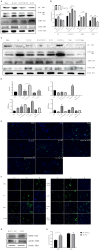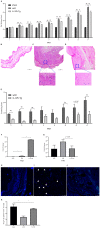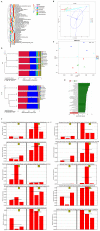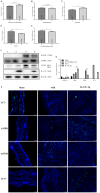IL-37 Ameliorating Allergic Inflammation in Atopic Dermatitis Through Regulating Microbiota and AMPK-mTOR Signaling Pathway-Modulated Autophagy Mechanism
- PMID: 32411145
- PMCID: PMC7198885
- DOI: 10.3389/fimmu.2020.00752
IL-37 Ameliorating Allergic Inflammation in Atopic Dermatitis Through Regulating Microbiota and AMPK-mTOR Signaling Pathway-Modulated Autophagy Mechanism
Abstract
Interaction between eosinophils and dermal fibroblasts is essential for provoking allergic inflammation in atopic dermatitis (AD). In vitro co-culture of human eosinophils and dermal fibroblasts upon AD-related IL-31 and IL-33 stimulation, and in vivo MC903-induced AD murine model were employed to investigate the anti-inflammatory mechanism of IL-1 family cytokine IL-37 in AD. Results showed that IL-37b could inhibit the in vitro induction of AD-related pro-inflammatory cytokines IL-6 and TNF-α, and chemokines CXCL8, CCL2 and CCL5, increase autophagosome biogenesis-related LC3B, and decrease autophagy-associated ubiquitinated protein p62 by regulating intracellular AMP-activated protein kinase (AMPK) and mammalian target of rapamycin (mTOR) signaling pathway. In CRISPR/Cas9 human IL-37b knock-in mice, IL-37b could significantly alleviate MC903-stimulated ear tissue swelling, itching sensation and the level of circulating cytokine IL-6 and ear in situ expression of AD-related TNF-α, CCL5 and transforming growth factor-β. Moreover, IL-37b could significantly upregulate Foxp3+ regulatory T cells (Treg) in spleen and ear together with significantly increased serum Treg cytokine IL-10, and decrease eosinophil infiltration in ear lesion. IL-37b knock-in mice showed a distinct intestinal microbiota metabolic pattern upon MC903 stimulation. Furthermore, IL-37b restored the disordered gut microbiota diversity, through regulating the in vivo autophagy mechanism mediated by intestinal metabolite 3-methyladenine, adenosine monophosphate, 2-hydroxyglutarate, purine and melatonin. In summary, IL-37b could significantly ameliorate eosinophils-mediated allergic inflammation via the regulation of autophagy mechanism, intestinal bacterial diversity and their metabolites in AD. Results therefore suggest that IL-37 is a potential anti-inflammatory cytokine for AD treatment.
Keywords: IL-37; allergic inflammation; atopic dermatitis; autophagy; eosinophils; microbiota.
Copyright © 2020 Hou, Sun, Zhu, Hon, Jiang, Chu, Tsang, Lam, Zeng and Wong.
Figures






References
Publication types
MeSH terms
Substances
LinkOut - more resources
Full Text Sources
Miscellaneous

